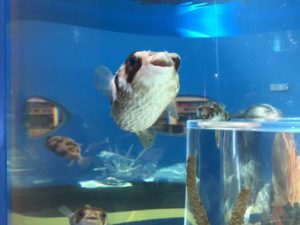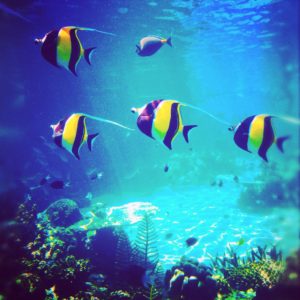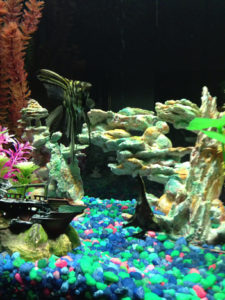What and How Saltwater Aquarium Cycle Work? There is a lot of helpful information about the saltwater aquarium cycle. Be sure to read our tips, tricks, and secrets for making your saltwater fish tank successful!
1. You need a well-lit room in order to grow healthy plants in your saltwater aquarium.
2. It’s important to keep an eye on your biofilter and clean it when needed, this will optimize cycling in the tank.
3. When adding fish to the tank you want to add one or two at a time so they don’t get stressed and release toxins in the water and kill the other fish in the tank!
Some of this information may seem simple to you, but it’s important to keep new saltwater aquarium owners informed on the basics about how a saltwater fish tank cycle works and why they shouldn’t add new fish before cycling their tank. A lot of people want to rush into getting new marine fish without doing some research first and that causes a lot of fish to die that otherwise could have survived. By taking the time to read an informative blog about how the saltwater cycle work, you can prevent your new fish from dying and become a more experienced saltwater aquarium owner in the end.
The fish disease usually manifests itself in one of three ways, which are; abnormal behavior, abnormal appearance/physical deformity, and external parasites (in saltwater this is usually ich or marine velvet). There are two types of disease prevention; prophylactic treatment (prevention) and therapeutic treatment (treatment). The main medications used for these treatments come in several forms; ointments, bath treatments, powders, and food additives. The most common medications available at local pet stores are powders that are added to the saltwater in the aquarium.
The fish disease can be caused by stress, which in turn can be caused by poor water quality/ammonia poisoning, improper care (high nitrate levels), or introduction of incompatible species. Prevention is important in maintaining healthy fish so read up on how to prevent diseases in your saltwater tank!
Saltwater fish are prone to a number of different types of diseases and parasites. Some common Saltwater fish diseases include Marine Ich, Marine Velvet and Amyloodinium Ocellatum commonly known as Marine White Spot Disease. It’s important to treat these infections immediately because they will spread very rapidly if not addressed early enough! Common medications used for treatment include CopperSafe, Cupramine and Discoed.
The fish disease usually manifests itself in one of three ways, which are; abnormal behavior, abnormal appearance/physical deformity and external parasites (in salt water this is usually ich or marine velvet). There are two types of disease prevention; prophylactic treatment (prevention) and therapeutic treatment (treatment). The main medications used for these treatments come in several forms; ointments, bath treatments, powders, and food additives. The most common medications available at local pet stores are powders that are added to the saltwater in the aquarium.
Saltwater fish tanks require a lot more attention than freshwater tanks because keeping your tank clean can be a little more difficult due to the presence of coral! You’ll need a good skimmer and a protein skimmer (which you cannot use for your freshwater aquarium). Test kits are also very important and many saltwater hobbyists recommend investing in more than one kind of test kit because different tests measure different things which is why we created the below table that compares the top 5 best-selling test kits on Amazon.com!
The fish disease usually manifests itself in one of three ways, which are; abnormal behavior, abnormal appearance/physical deformity and external parasites (in salt water this is usually ich or marine velvet). There are two types of disease prevention; prophylactic treatment (prevention) and therapeutic treatment (treatment). The main medications used for these treatments come in several forms; ointments, bath treatments, powders, and food additives. The most common medications available at local pet stores are powders that are added to the saltwater in the aquarium.
Saltwater fish tanks require a lot more attention than freshwater tanks because keeping your tank clean can be a little more difficult due to the presence of coral! You’ll need a good skimmer and a protein skimmer (which you cannot use for your freshwater aquarium). Test kits are also very important and many saltwater hobbyists recommend investing in more than one kind of test kit because different tests measure different things which is why we created the below table that compares the top 5 best-selling test kits on Amazon.com!
Keeping your saltwater aquarium clean may sound like an easy task, but as with any other hobby, saltwater fish tanks require a lot of work! Saltwater aquariums can be very beautiful and relaxing to watch but they do require a bit more maintenance. In addition to routine cleaning of your aquarium, you’ll also have to deal with things such as water temperature fluctuations and maintaining the proper pH level.
In order to keep your tank clean, you will need a good filtration system that includes a protein skimmer which is vital for removing organic waste from the water before it breaks down into ammonia. The best way to test your tank’s water quality is by checking pH levels daily using an accurate test kit. You should also invest in multiple test kits so that you can measure specific elements in your tank’s water including ammonia, nitrite, and nitrate levels.
Aquarium maintenance is a must
Keeping your saltwater aquarium clean may sound like an easy task, but as with any other hobby, saltwater fish tanks require a lot of work! Saltwater aquariums can be very beautiful and relaxing to watch but they do require a bit more maintenance. In addition to routine cleaning of your aquarium, you’ll also have to deal with things such as water temperature fluctuations and maintaining the proper pH level.
In order to keep your tank clean, you will need a good filtration system that includes a protein skimmer which is vital for removing organic waste from the water before it breaks down into ammonia. The best way to test your tank’s water quality is by checking pH levels daily using an accurate test kit. You should also invest in multiple test kits so that you can measure specific elements in your tank’s water including ammonia, nitrite, and nitrate levels.
Aquarium maintenance is a must
We’ve all heard the expression “easy as taking candy from a baby,” but in this case it could not be more true! Maintaining a saltwater aquarium is very easy once you understand what you need to do and when you need to do it. In addition to performing weekly 10-15% water changes, make sure your equipment is up to par by doing things like checking pH levels daily with an accurate test kit, running carbon three times per week (you’ll also want to run activated carbon if your tank uses resins) and maintaining proper salinity (by monitoring specific gravity) among other things.
Saltwater aquariums require a lot of work
Before you stock your tank with fish, corals, and invertebrates it is important to cycle your aquarium. In this article, we’ll show you how to get the nitrogen cycle going in your saltwater tank so that you can add livestock! In addition to this article, if you’d like more information about cycling an aquarium be sure to check out ourtopics To The Saltwater Aquarium Cycle where we talk about types of filtration, ammonia readings, nitrites readings, and much more!
Cycling a new saltwater aquarium takes time. Be patient!
We’ve all heard the expression “easy as taking candy from a baby,” but in this case it could not be more true! Maintaining a saltwater aquarium is very easy once you understand what you need to do and when you need to do it. In addition to performing weekly 10-15% water changes, make sure your equipment is up to par by doing things like checking pH levels daily with an accurate test kit, running carbon three times per week (you’ll also want to run activated carbon if your tank uses resins) and maintaining proper salinity (by monitoring specific gravity) among other things.
Saltwater aquariums require a lot of work
There are so many different types of saltwater aquarium fish out there that it can sometimes be overwhelming when deciding what type of fish will live in your tank. Keep reading to learn about some of the most popular saltwater aquarium fish and what you need to know before purchasing them.
The 10 most common saltwater fish for beginners
There are so many different types of saltwater aquarium fish out there that it can sometimes be overwhelming when deciding what type of fish will live in your tank. Keep reading to learn about some of the most popular saltwater aquarium fish and what you need to know before purchasing them.

